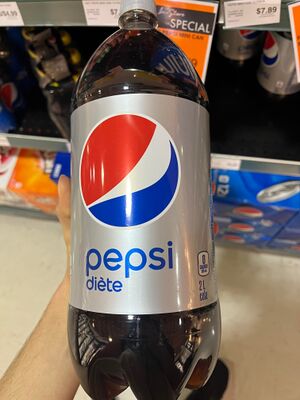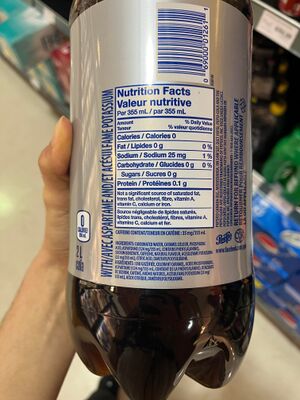Course:FNH200/Assignments/2022/Pepsi Regular Diet



History and Overview
Pepsi and Diet Pepsi are carbonated soft drinks (Cola-beverages) produced by PepsiCo, a U.S. based multinational food corporation owning brands such as Quaker, Mountain Dew, Gatorade, Pepsi, and Diet Pepsi.[1]Pepsi was originally created by American pharmacist Caleb Bradham under his own name until it was re-named and shortened to Pepsi in 1961.[2]During the 1940’s, economic uncertainty in America made Pepsi a popular Cola-beverage due to its low cost and convenient 12-ounce bottle format. The brand has since been known for its creative marketing and rivalry with Coca-Cola. Coined the “Cola Wars”, the two companies targeted each other throughout the 1980’s by launching ad-campaigns condescending the rival products.[3]
Even though Coca Cola controls the majority share of the carbonated soft drink market today, Pepsi still reaches customers through their distinct flavours, niche marketing and sponsorships, as well as different flavoured varieties and low-calorie alternatives such as Pepsi Zero and Diet Pepsi.[4]Diet Pepsi offers similar taste to the original Pepsi product, but with a no-calorie intake by adding artificial sweeteners instead of regular sugar.[5]
Today, both regular Pepsi and Diet Pepsi are available for purchase online and in stores around the world. However, a steady decline in the sale of soda drinks, especially diet sodas, over the last years due to more consumer choices in the market forced Pepsi to re-think their original recipe for Diet Pepsi and add different kinds of sweeteners to improve the product.[6]

Ingredient lists
Pepsi:
| Ingredients | Food Identity | Functional Properties | Other Notes |
|---|---|---|---|
| Carbonated water | Base ingedient | -Gives bubbles
-Creates fizziness |
-Water infused with carbon dioxide gas |
| Glucose-fructose (high fructose corn syrup) | Sugar | -Sweetener | -Made from corn stach[7] |
| Caramel colour | Additive | -Food coloring
-Gives dark, caramel like color |
-Water-soluble food coloring made through carmelization[8] |
| Phosphoric acid | Additive | -Gives sharp, tangy flavour
-Extends shelf life, prevents growth of mold and bacteria |
-Viscous liquid or tasteless and oderless solid
-Commonly used in food, drinks, fertilier and anti-rust metal |
| Caffeine | Additive | -Bitter flavour counteracts overpowering sweetness | -Stimulant
-Increases alertness and attentional performance in consumers [9] |
| Citric acid | Additive | -Provides tangy taste
-Gives bubbles and creates fiziness by reacting with carbonate in baking soda and forms carbon dioxide[10] |
-pH of 3-6[11]
-Acic found in citrus fruits |
| Natural flavour | -Flavoring | -extracted from natural fruits, vegetables or herbs.[12] |
Diet Pepsi:
| Ingredients | Food Identity | Functional Properties | Other Notes |
|---|---|---|---|
| Carbonated Water | Base ingedient | -Gives bubbles
-Creates fizziness |
-Water infused with carbon dioxide gas |
| Caramel colour | Additive | -Food coloring
-Gives dark, caramel like color |
-Water-soluble food coloring made through carmelization[8] |
| Phosphoric acid | Additive | -Gives sharp, tangy flavour
-Extends shelf life, prevents growth of mold and bacteria |
-Viscous liquid or tasteless and oderless solid
-Commonly used in food, drinks, fertilier and anti-rust metal |
| Aspertame (124 mg/355 mL, contains phenylalanine) | Sugar substitute | -Sweetener | -180-220 times sweeter than sucrose |
| Sodium Benzoate | Additive | -Food preservative | -Sodium salt of benzoate
-Produced by neutralization of sodium hydroxide and benzoic acid[13] -Common preservative and pickling agent |
| Caffeine | Additive | -Bitter flavour counteracts overpowering sweetness | -Stimulant
-Increases alertness and attentional performance in consumers [9] |
| Natural Flavour | -Flavoring | -extracted from natural fruits, vegetables or herbs.[12] | |
| Acesulfame Potassium | Sugar substitue | -Sweetener | -Similar to aspartame but with lower or no calories |
| Citric Acid | Additive | -Provides tangy taste
-Gives bubbles and creates fiziness by reacting with carbonate in baking soda and forms carbon dioxide |
-pH of 3-6
-Acic found in citrus fruits |
| Dimethylpolysiloxaxne | Additive | -Silicon (conditioning and foam-controlling agent)[14]
-Reduces surface tension to prevent the build-up of foam on the liquids’ surface |
-Applications beyond the food industry include health care, cosmetics, and chemical fields
-A clear, colourless, and tasteless anti-foaming agent mainly used in fruit- and vegetable juices[14] |
Pepsi vs Diet Pepsi
The difference between regular Pepsi and Diet Pepsi is the addition of Aspartame, Sodium Benzoate, Acesulfame Potassium, and Dimethylpolysiloxaxne in the Diet version.
The Aspartame and Acesulfame Potassium are sweeteners that were added to substitute the high fructose corn syrup of the Regular Pepsi.
The sodium benzoate acts as a food preservative and the Dimethylpolysiloxaxne acts as a foam controlling agent.
Labels
Labels for (Original) Pepsi and (Diet) Pepsi are written in English and French and include:
- Product names (Pepsi; Diet Pepsi)
- Pepsi logo (red-, white-, and blue design in a sphere like shape)
- Name, contact, and address of PepsiCo (PepsiCo Canada ULC, Mississauga)
- List of ingredients in descending order of proportion (see ingredient list section)
- Nutritional Facts Table showing the amount of nutrients per 355 mL, as well as their % daily value:
- Calories
- Fat
- Sodium
- Carbohydrates
- Sugars
- Protein
- Saturated fat, trans fat, cholesterol, fiber, Vitamin A, Vitamin C, calcium, and iron (not a significant source)
- Caffeine Content in mg/mL
- Net Quantity (2L bottle)
- Date marking
- Best-before dates
- For Diet Pepsi:
- Includes a statement saying “with Aspartame and Acesulfame Potassium”
- Lists Aspartame and Acesulfame Potassium in the list of ingredients
- Indicate the aspartame and Acesulfame Potassium content in milligrams per serving
- States that Aspartmate contains phenylalanine”
Both the labels of Diet and Regular Pepsi complies with the regulatory requirements as outlined in section 4.3 (Consumer Packaging and Labelling Act and Regulations).
They include bilingual labelling (English and French), the common name of the Food (Pepsi), date marking (best-before date), Identity and Principal Place of Business (PepsiCo Canada ULC, Mississauga), Legibility and location, List of ingredients in descending order of proportion, Nutrition Facts table, Net quantity of the food, and sweeteners. Also, for Diet Pepsi, it complies with the Aspartame requirements.
References
- ↑ Our products. PepsicoUpgrade. (n.d.). Retrieved July 19, 2022, from https://www.pepsico.com/our-brands/creating-smiles/our-products
- ↑ Encyclopædia Britannica, inc. (n.d.). PepsiCo, Inc.. Encyclopædia Britannica. Retrieved July 19, 2022, from https://www.britannica.com/topic/PepsiCo-Inc
- ↑ Yahoo! (n.d.). The history of Coca-Cola and Pepsi's rivalry - and which is the better investment. Yahoo! News. Retrieved July 19, 2022, from https://ca.news.yahoo.com/history-coca-cola-pepsi-rivalry-150038098.html
- ↑ Our products. PepsicoUpgrade. (n.d.). Retrieved July 19, 2022, from https://www.pepsico.com/our-brands/creating-smiles/our-products
- ↑ The facts about your favorite beverages (U.S.): Product. The Facts About Your Favorite Beverages (U.S.) | product. (n.d.). Retrieved July 19, 2022, from https://www.pepsicobeveragefacts.com/Home/product?formula=F0000007855&form=RTD&size=20
- ↑ Whitten, S. (2016, June 27). Pepsi relaunches Diet Pepsi with aspartame following sharp decline in sales. CNBC. Retrieved July 19, 2022, from https://www.cnbc.com/2016/06/27/pepsi-relaunches-diet-pepsi-with-aspartame-following-sharp-decline-in-sales.html
- ↑ Factsheet on glucose fructose syrup and isoglucose. Starch Europe. (2020, September 21). Retrieved July 19, 2022, from https://starch.eu/priority/factsheet-on-glucose-fructose-syrups-and-isoglucose/?redirect=true
- ↑ 8.0 8.1 Benefits. ITCA. (2017, April 25). Retrieved July 19, 2022, from https://www.caramelfacts.org/benefits/
- ↑ 9.0 9.1 Caffeine. The Nutrition Source. (2020, November 12). Retrieved July 19, 2022, from https://www.hsph.harvard.edu/nutritionsource/caffeine/
- ↑ Chant, J. (2021, August 24). What is citric acid - industry news. Monarch Chemicals. Retrieved July 19, 2022, from https://www.monarchchemicals.co.uk/Information/News-Events/440-/The-Role-of-Citric-Acid-in-the-Food-amp-Drink-Industry
- ↑ MediLexicon International. (n.d.). Citric acid: Structure, uses, intolerance, and more. Medical News Today. Retrieved July 19, 2022, from https://www.medicalnewstoday.com/articles/citric-acid#:~:text=Citric%20acid%20has%20a%20pH,14%2C%20with%207%20being%20neutral.
- ↑ 12.0 12.1 The facts about your favorite beverages (U.S.): Product. The Facts About Your Favorite Beverages (U.S.) | product. (n.d.). Retrieved July 19, 2022, from https://www.pepsicobeveragefacts.com/Home/product?formula=F0000007855&form=RTD&size=20
- ↑ Lennerz, B. S., Vafai, S. B., Delaney, N. F., Clish, C. B., Deik, A. A., Pierce, K. A., Ludwig, D. S., & Mootha, V. K. (2015, January). Effects of sodium benzoate, a widely used food preservative, on glucose homeostasis and metabolic profiles in humans. Molecular genetics and metabolism. Retrieved July 19, 2022, from https://www.ncbi.nlm.nih.gov/pmc/articles/PMC4289147/
- ↑ 14.0 14.1 Aditya, Joy, O., J., & Reeve, I. (2021, October 2). What is dimethylpolysiloxane (E900) in food and what are the uses? FOODADDITIVES. Retrieved July 19, 2022, from https://foodadditives.net/antifoaming-agent/dimethylpolysiloxane/
| This Food Science resource was created by Course:FNH200. |
